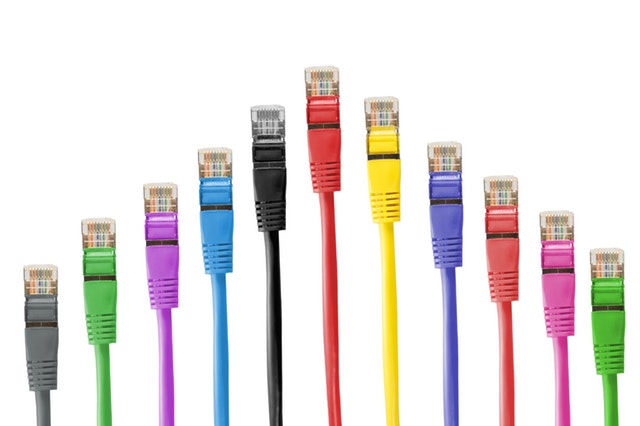
This post was originally published January 19, 2012 on my old blog.
Telephony is definitely not an area for the color blind. Telephone cables and wires are all color coded to help with pair identification.
Mainly in older installations you will find the Bell Company solid color code which was as follows:
| Pair One | Green | Red |
| Pair Two | Black | Yellow |
| Pair Three | White | Blue |
This scheme did continue for larger numbers of pairs, but it is rare to see any cables with more than three pair left in service.
The modern scheme uses a repeated combination of a group color with a pair color. The group and pair colors are:
| Group | Pair |
| White | Blue |
| Red | Orange |
| Black | Green |
| Yellow | Brown |
| Violet | Slate |
So using the group and pair colors, the first group of pairs will all have white matched with a color. Usually, the white wire has a tracer of the pair color to help with identification in case the cables become unwound. Using these colors, you can uniquely identify 25 pairs. Because the 25 pair cable and related termination on punch down blocks and other terminations are quite common, I have listed out the entire cable pair color chart below.
| Pair # | First wire | Second wire |
|---|---|---|
| 1 | White | Blue |
| 2 | Orange | |
| 3 | Green | |
| 4 | Brown | |
| 5 | Slate | |
| 6 | Red | Blue |
| 7 | Orange | |
| 8 | Green | |
| 9 | Brown | |
| 10 | Slate | |
| 11 | Black | Blue |
| 12 | Orange | |
| 13 | Green | |
| 14 | Brown | |
| 15 | Slate | |
| 16 | Yellow | Blue |
| 17 | Orange | |
| 18 | Green | |
| 19 | Brown | |
| 20 | Slate | |
| 21 | Violet | Blue |
| 22 | Orange | |
| 23 | Green | |
| 24 | Brown | |
| 25 | Slate |
Once you go past 25 pairs, the pattern repeats by using colored ribbons called binders to wrap each set of 25 pairs. So the first set would be wrapped in white and blue ribbons, the next white and orange and so on.
In networking, we’ve adopted the same color code for Ethernet cabling, but with only 4 pairs we only use part of the color scheme. The Ethernet TIA586A and TIA586B standards define two different ways to terminate an Ethernet cable into an RJ-45 or an 8p8c connector. Most use the B standard which places pair one (white/blue) in pins 4 and 5 which corresponds to line one in telephony. Line two which is pins 3 and 6 is pair 3 (white/green). TIA586A, on the other hand, puts pair 2(white/orange) in the pins 3 and 6. This allows the termination to correspond to telephony line 2. Mostly this is just knowledge to have for reference, but you may run across TIA586A in the wild.
